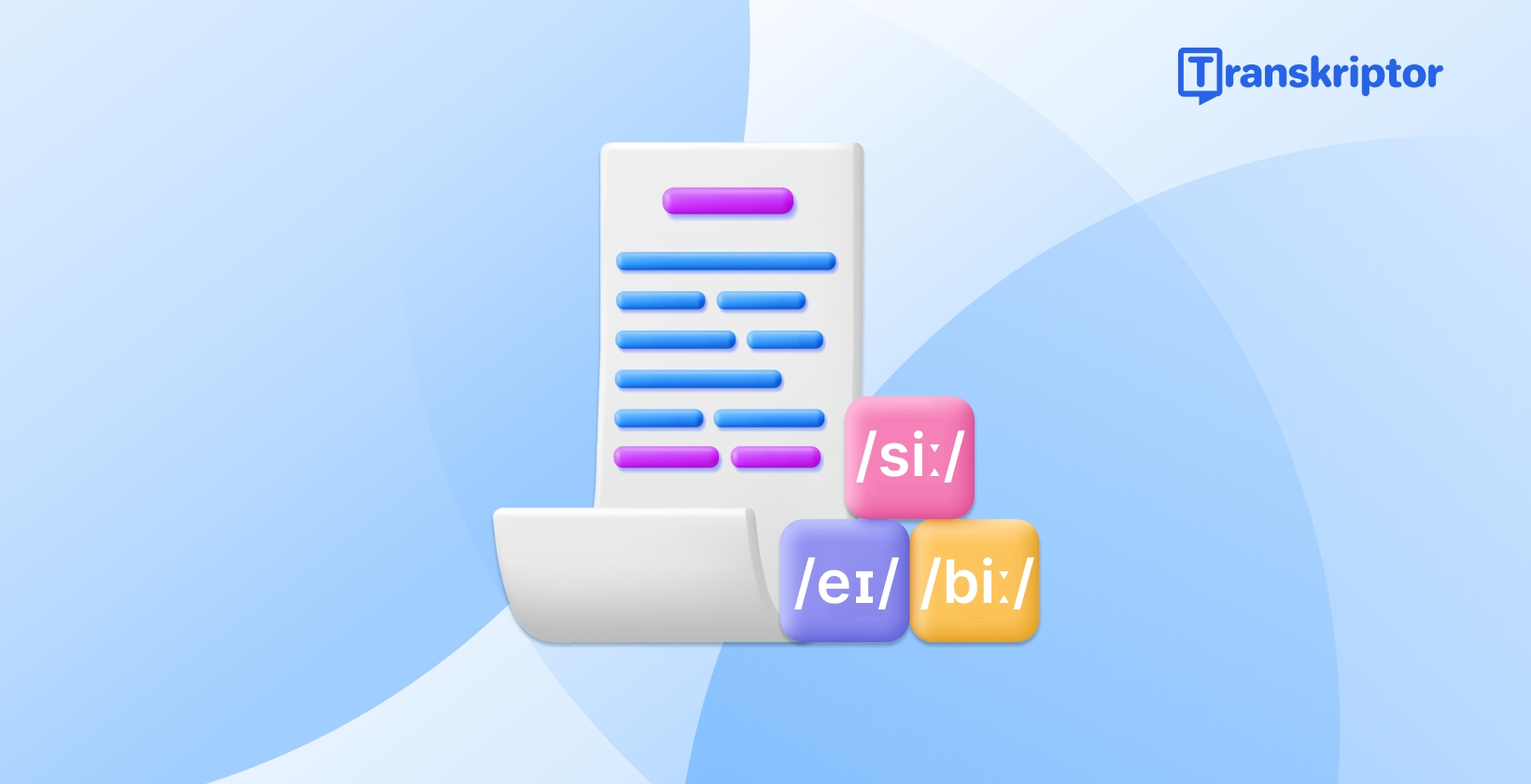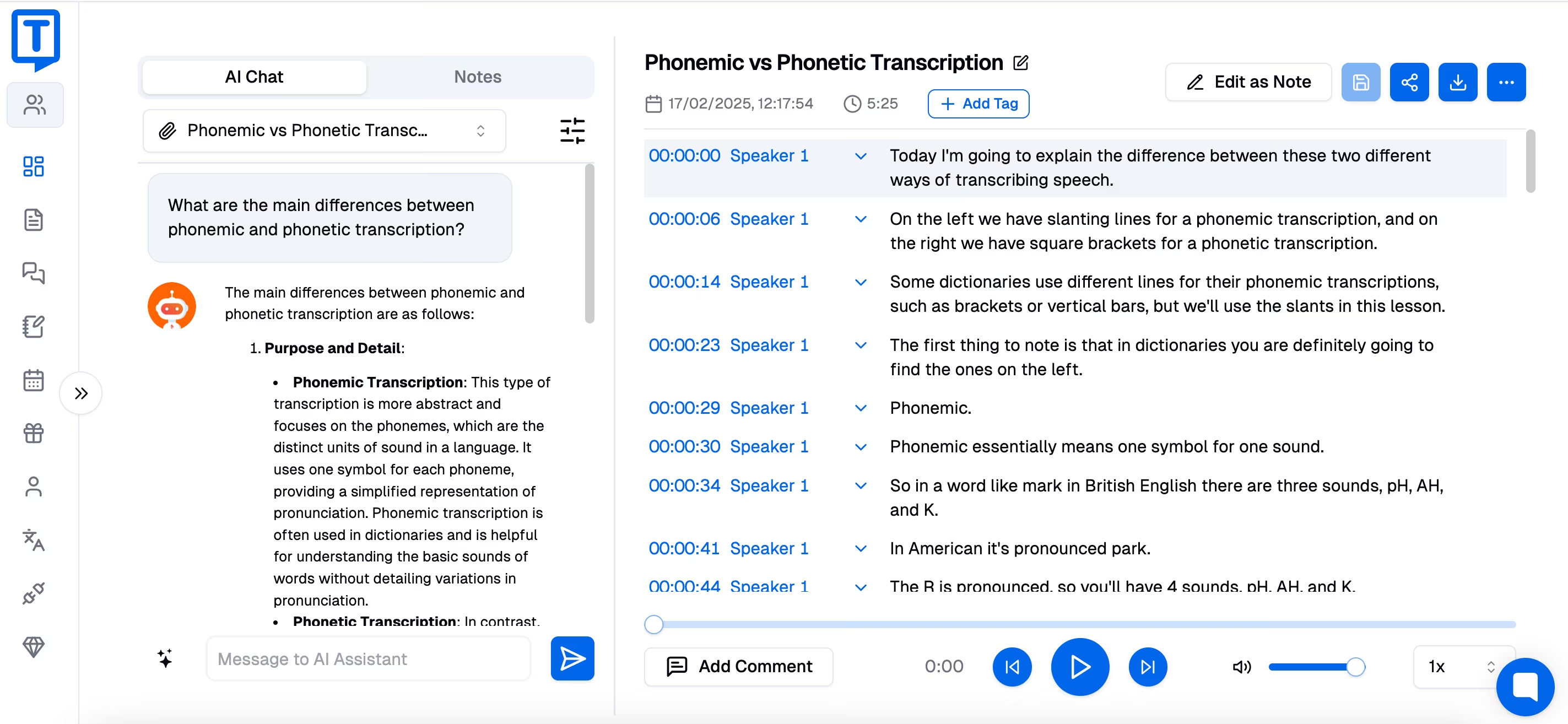
Phonetic Transcription Guide: Learn IPA Symbols
Transcribe, Translate & Summarize in Seconds
Transcribe, Translate & Summarize in Seconds
Learning a new language can be an exciting journey, but mastering pronunciation can often be a significant hurdle. Written text alone often fails to capture the nuances of spoken language, leading to mispronunciations and misunderstandings.
This comprehensive guide will equip you with the knowledge and tools you need to decipher the phonetic transcription of words and improve your pronunciation. We'll cover everything from the basics of the International Phonetic Alphabet (IPA) to advanced techniques and helpful resources, including a look at Transkriptor, a leading transcription solution.

Understanding Phonetic Transcription Basics
Phonetic transcription is a system for writing down the sounds of speech. It's crucial for accurately representing pronunciation, especially in languages like English where spelling and pronunciation often diverge. Here below is a closer look at phonetic symbols' meaning:
What is the International Phonetic Alphabet (IPA)?
The International Phonetic Alphabet (IPA ) is a standardized system of phonetic notation that uses a unique symbol for each distinct sound in spoken language. This eliminates the ambiguities of traditional orthography and provides a consistent way to represent pronunciation across different languages. Understanding the IPA is the first step in learning phonetic transcription.
Why Learn Phonetic Transcription?
Learning phonetic transcription offers numerous benefits. It allows you to accurately learn the pronunciation of new words, improve your accent, and understand the subtle differences in pronunciation between dialects. It's an invaluable tool for language learners, teachers, and anyone interested in phonetics. A solid understanding of how to read phonetic transcription will significantly enhance your language learning experience.
Key Components of Phonetic Symbols
Phonetic symbols represent individual sounds, including consonants, vowels, and other sound features like stress and intonation. Understanding the different categories of sounds and how they are represented in the IPA is essential for deciphering phonetic transcriptions.
Essential IPA Symbols Guide
The IPA chart organizes symbols based on the articulatory features of the sounds they represent, such as where in the mouth the sound is produced and how the air is modified. Here is a guide about IPA symbols:
Consonant Symbols and Sounds
Consonants are sounds produced by obstructing the airflow in the vocal tract. The IPA chart lists consonants according to their place and manner of articulation. For example, /p/ and /b/ are both bilabial consonants (produced with the lips), but /p/ is voiceless while /b/ is voiced. A good IPA symbols guide will help you understand the distinctions between these sounds.
Vowel Symbols and Sounds
Vowels are sounds produced with relatively free airflow in the vocal tract. They are classified by tongue position (high, mid, low; front, central, back) and lip rounding. For instance, /i:/, as in "see," is a high front unrounded vowel, while /ɑ:/, as in "father," is a low back unrounded vowel. Learning the vowel symbols is key to mastering English phonetic alphabet pronunciation.
Diphthongs and Special Characters
Diphthongs are combinations of two vowel sounds within a single syllable. The IPA also includes symbols for other phonetic features, such as stress, intonation, and tone. These "special characters" add further detail to the phonetic transcription.
How to Read Phonetic Transcription
Learning how to read phonetic transcription is like learning a new code. It requires understanding the symbols and their corresponding sounds, as well as the rules that govern how they are combined:
Basic Rules and Guidelines
IPA transcription rules di
te how sounds are represented and how words are transcribed. These rules cover aspects like stress placement, vowel length, and the representation of connected speech. Understanding these rules is crucial for accurate interpretation.
Common Patterns in English Phonetics
English pronunciation exhibits certain patterns, such as the aspiration of certain consonants (e.g., the /p/ in "pin") and the reduction of unstressed vowels. Familiarity with these patterns can aid in understanding and predicting pronunciation. Learning about common patterns can greatly assist those who want to learn phonetic transcription.
Practice Examples and Exercises
The best way to learn how to read phonetic transcription is through practice. Working through examples and exercises, using a phonetic pronunciation guide, and comparing your transcriptions with standard ones will solidify your understanding. You can find phonetic transcription examples online and in textbooks.
Tools and Resources for Phonetic Transcription
Here below are the tools and resources for phonetic transcription:

Professional Transcription Solutions
For professional transcription needs, accuracy and efficiency are paramount. Transkriptor is an advanced transcription service that utilizes AI to provide highly accurate transcriptions in multiple languages. Its multilingual capabilities make it a valuable tool for international students, language teachers, and linguistics professionals. After you get your accurate transcription within seconds with Transkriptor, you can turn them into phonetic transcription according to your needs.
Transkriptor supports a wide range of languages, making it ideal for transcribing audio and video content in diverse linguistic contexts. Transkriptor's advanced speech recognition technology ensures high accuracy and speed, saving users time and effort. Its user-friendly interface and various export options make it a convenient solution for all transcription needs.
With Transkriptor, you can upload all kinds of audio and video file formats, such as MP3, MP4, and WAV. This large scale ensures you don’t need third-party apps to convert your file format. Similarly, Transkriptor provides rich exporting options, including PDF, SRT, and DOC so that you can get your transcriptions in any desired format.

Another advanced feature Transkriptor offers is the AI Chat, which answers your questions about your transcript. You can either use the question templates or write down your own questions and the AI will give you accurate answers within seconds. Additionally, Transkriptor provides you with a “Notes” section in which you can get a summary of your transcription within seconds or you can write down your own notes.
Alternative Tools and Methods
Several alternative tools and methods can be used for phonetic transcription, each with its own strengths and weaknesses. Here are a few examples:
- Online Dictionaries with IPA: Many online dictionaries, such as Merriam-Webster and Oxford Learner's Dictionaries , provide online phonetic converter. These can be helpful for quickly checking the pronunciation of a word.
- Phonetic Fonts: Phonetic fonts, such as Doulos SIL and Charis SIL , allow you to type IPA symbols directly into documents. This can be useful for creating your own phonetic transcriptions.
- Manual Transcription: Manual transcription involves listening to audio recordings and writing down the sounds using IPA symbols. This can be a time-consuming process, but it can also be a good way to develop your ear for phonetic distinctions.

- Rev: Rev offers both AI-powered and human transcription services, catering to different accuracy and speed needs. Their human transcription service boasts high accuracy, making it suitable for professional use.

- Otter.ai: Otter.ai specializes in AI-powered transcription, emphasizing real-time capabilities and affordability. Its features, like OtterPilot, an AI meeting assistant, make it a popular choice.
Advanced Techniques for Mastering Pronunciation
Beyond simply reading phonetic transcription, there are techniques you can use to actively improve your pronunciation:
Using Transcription for Language Learning
Phonetic transcription can be a powerful tool for language learning. By comparing the transcription of a word with its pronunciation, you can identify areas where your pronunciation differs from the standard and work on correcting them.
Common Challenges and Solutions
Learning phonetic transcription can be challenging, especially for beginners. Common difficulties include memorizing the symbols, distinguishing between similar sounds, and applying the rules of transcription. These challenges can be overcome through practice, using resources like this IPA symbols guide, and seeking feedback from language teachers or native speakers.
Professional Tips and Best Practices
To maximize the benefits of phonetic transcription, it's essential to use reliable resources, practice regularly, and focus on specific areas of pronunciation that need improvement. Consulting with a language professional can provide personalized guidance and feedback.
Conclusion
This guide has provided a comprehensive overview of phonetic transcription, covering everything from the basics of the IPA to advanced techniques for mastering pronunciation. We've explored the importance of phonetic transcription for language learning, the key components of phonetic symbols, and how to read and use phonetic transcriptions effectively. Remember, tools like Transkriptor can greatly assist you in this process.
By understanding and utilizing phonetic transcription, you can significantly improve your pronunciation and communication skills. Try Transkriptor today and experience the difference it can make in your language-learning journey.
Frequently Asked Questions
The IPA is a standardized system of phonetic notation. It uses a unique symbol for every distinct sound in spoken language, eliminating the inconsistencies of traditional spelling. Understanding the IPA is the foundation for learning phonetic transcription.
Learning to read phonetic transcription involves understanding the IPA symbols, the rules of transcription, and practicing regularly. Using a phonetic pronunciation guide, working through examples, and comparing your transcriptions with standard ones will solidify your understanding.
Yes, many free resources are available online, including IPA charts, pronunciation guides, and videos. This guide is a great starting point, and many websites and apps offer free IPA learning materials.
By comparing the phonetic transcription of a word with its actual pronunciation, you can identify discrepancies and work on correcting them. This can involve practicing individual sounds, focusing on stress and intonation, and seeking feedback from others.

